preface to the anglo-american cataloguing rules, second edition
preface to the anglo-american cataloguing rules, second edition
preface to the anglo-american cataloguing rules, second edition
You also want an ePaper? Increase the reach of your titles
YUMPU automatically turns print PDFs into web optimized ePapers that Google loves.
PREFACE TO THE ANGLO-AMERICAN CATALOGUING RULES, SECONDEDITION (1978)The first <strong>edition</strong> of <strong>the</strong> Anglo-American Cataloguing Rules, in its separately publishedNorth American and British texts, was <strong>the</strong> product of <strong>the</strong> inspired edi<strong>to</strong>rship successivelyof Seymour Lubetzky and C. Sumner Spalding and <strong>the</strong> culmination of many years’activity by a large number of individuals, <strong>to</strong> whom credit and acknowledgment weregiven in that <strong>edition</strong>. This <strong>second</strong> <strong>edition</strong> does not supersede <strong>the</strong>ir work, but continues it:for, in spite of <strong>the</strong> changes in presentation and content which it introduces, <strong>the</strong>se are still<strong>the</strong> Anglo-American Cataloguing Rules, having <strong>the</strong> same principles and underlyingobjectives as <strong>the</strong> first <strong>edition</strong>, and being firmly based on <strong>the</strong> achievement of those whocreated <strong>the</strong> work, first published in 1967.The starting point for this new <strong>edition</strong> is, indeed, <strong>the</strong> very clear success of <strong>the</strong> 1967 textsin meeting <strong>the</strong> needs of large numbers—and many different kinds—of libraries during aperiod in which <strong>the</strong>re have been considerable growth in libraries and extensions ofcatalogue processes, bibliographic services, and national library services; not only in <strong>the</strong>three "Anglo-American" countries for which AACR was established, but throughout <strong>the</strong>world. AACR has been adopted by major libraries and agencies in most English-speakingcountries, and has had a considerable influence on <strong>the</strong> formation or revision of local andnational <strong>cataloguing</strong> <strong>rules</strong> in a number of o<strong>the</strong>rs. For ten years it has thus been subjected<strong>to</strong> <strong>the</strong> critical test of application over a very wide range of professional practice across <strong>the</strong>world.During this time mechanization, <strong>the</strong> growth of centralized and cooperative bibliographicservices and networks, <strong>the</strong> development and unification of services in <strong>the</strong> nationallibraries (especially, in <strong>the</strong> AACR context, those of <strong>the</strong> United Kingdom and Canada)—all <strong>the</strong>se have had, as <strong>the</strong>y continue <strong>to</strong> have, significant effects on <strong>the</strong> assembly,transmission, and catalogue exploitation of bibliographic information, both withinlibraries and between libraries. And, <strong>the</strong> introduction in<strong>to</strong> most libraries of increasingnumbers of <strong>the</strong> new media that have established <strong>the</strong>mselves in <strong>the</strong> same period as havinga parallel importance, for many library users, with <strong>the</strong> paper-based and printed documentstraditionally <strong>the</strong> staple of <strong>the</strong> processing and <strong>cataloguing</strong> department, has created orintensified integrative problems on a scale unpredictable by those who wrought <strong>the</strong> 1967texts.A "memorandum of agreement" of 1966 between <strong>the</strong> American Library Association(ALA) and <strong>the</strong> [British] Library Association provided a means of continuing review by<strong>the</strong>se two bodies of <strong>the</strong> 1967 texts after publication, so that appropriate action byamendment and addition might be taken <strong>to</strong> deal with any problems encountered by userson account ei<strong>the</strong>r of errors and ambiguities or of changing circumstances. The forum forthat review was <strong>the</strong> Descriptive Cataloging Committee (DCC) of <strong>the</strong> ALA Resources andTechnical Services Division; and from 1969 <strong>to</strong> 1974 regular meetings of DCC wereattended by representatives of <strong>the</strong> Cataloguing Rules Committee established by <strong>the</strong>Library Association, with formal representation also of <strong>the</strong> Library of Congress and <strong>the</strong>Canadian Library Association. At <strong>the</strong>se meetings a number of amendments and changesof <strong>the</strong> 1967 texts were agreed and promulgated; and some of <strong>the</strong> problems arising fromchanging circumstances were addressed for <strong>the</strong> first time, particularly those of <strong>the</strong>
treatment of nonbook materials. However, <strong>the</strong> memorandum did not stipulate agreementamong all parties as a condition of amendment <strong>to</strong> ei<strong>the</strong>r text and, while in one or twoimportant respects <strong>the</strong> differences between <strong>the</strong> two texts were diminished, <strong>the</strong>re weresome not unimportant issues on which <strong>the</strong>y seemed in some danger of moving fur<strong>the</strong>rapart. Fur<strong>the</strong>rmore, some significant problems were identified on which, although allparties were agreed on <strong>the</strong> line of development needed, <strong>the</strong> procedural mechanismsprovided by <strong>the</strong> memorandum were not wholly adequate for thorough examination andeffective action.At this stage, two new fac<strong>to</strong>rs made it both propitious and desirable <strong>to</strong> find a new meansof consolidating development since 1967 and of providing for <strong>the</strong> ascertainablerequirements of bibliographic control in <strong>the</strong> 1980s and beyond. These were, first, <strong>the</strong>proposed conclusion by <strong>the</strong> Library of Congress of <strong>the</strong> policy of "superimposition" bywhich its adoption of AACR had been limited; and, <strong>second</strong>, <strong>the</strong> establishment by <strong>the</strong>newly formed British Library of its policies of working alongside <strong>the</strong> Library ofCongress, <strong>the</strong> National Library of Canada, and o<strong>the</strong>r libraries and agencies, in <strong>the</strong>framework of national and international networks and standards for bibliographicrecords. Ano<strong>the</strong>r contribu<strong>to</strong>ry fac<strong>to</strong>r was <strong>the</strong> emergence, from <strong>the</strong> International Meetingof Cataloguing Experts held in Copenhagen in 1969, of a programme of InternationalStandard Bibliographic Description (ISBD) under <strong>the</strong> aegis of <strong>the</strong> InternationalFederation of Library Associations and Institutions (IFLA). This programme commencedwith a standard for monographs, ISBD(M), which was incorporated in<strong>to</strong> <strong>the</strong> two texts ofAACR in 1974 by means of separately published revisions of chapter 6.For <strong>the</strong>se reasons, and on <strong>the</strong> initiatives of ALA and <strong>the</strong> British Library, <strong>the</strong>re <strong>to</strong>ok placeat ALA headquarters in Chicago, in March 1974, a tripartite meeting—consisting of onedelegate each from <strong>the</strong> three "Anglo-American" countries, representing in each case both<strong>the</strong> library association and <strong>the</strong> national library—<strong>to</strong> draw up a new memorandum ofagreement and <strong>to</strong> complete <strong>the</strong> planning of <strong>the</strong> project for a <strong>second</strong> <strong>edition</strong> of AACR.OBJECTIVES AND POLICIESThe objectives established in <strong>the</strong> memorandum of <strong>the</strong> tripartite meeting may be brieflystated as follows:1) <strong>to</strong> reconcile in a single text <strong>the</strong> North American and British texts of 19672) <strong>to</strong> incorporate in <strong>the</strong> single text all amendments and changes already agreed andimplemented under <strong>the</strong> previous mechanisms3) <strong>to</strong> consider for inclusion in AACR all proposals for amendment currently underdiscussion between <strong>the</strong> American Library Association, <strong>the</strong> Library Association, <strong>the</strong>Library of Congress, and <strong>the</strong> Canadian Library Association; any new proposals putforward by <strong>the</strong>se bodies and <strong>the</strong> British Library; and any proposals of nationalcommittees of o<strong>the</strong>r countries in which AACR is in use4) <strong>to</strong> provide for international interest in AACR by facilitating its use in countries o<strong>the</strong>rthan <strong>the</strong> United States, Canada, and <strong>the</strong> United Kingdom. This final objective waslater intensified, as a condition of funding by <strong>the</strong> Council on Library Resources, <strong>to</strong>one of making a contribution <strong>to</strong> <strong>the</strong> development of an international <strong>cataloguing</strong> code.The tripartite meeting set up a Joint Steering Committee for Revision of AACR(JSCAACR), consisting of one voting and one nonvoting representative of each of <strong>the</strong>
five participating organizations, and provided for two edi<strong>to</strong>rs, one from ei<strong>the</strong>r side of <strong>the</strong>Atlantic. JSCAACR’s function has been <strong>to</strong> appoint <strong>the</strong> edi<strong>to</strong>rs, <strong>to</strong> consider all proposalsand determine questions of policy with <strong>the</strong> edi<strong>to</strong>rs, <strong>to</strong> assess for approval <strong>the</strong> <strong>rules</strong> framedby <strong>the</strong> edi<strong>to</strong>rs, and <strong>to</strong> present <strong>the</strong> final text for publication; and thus <strong>to</strong> be <strong>the</strong> ultimateauthority for <strong>the</strong> content and presentation of this <strong>second</strong> <strong>edition</strong>.An early result of JSCAACR’s consideration of <strong>the</strong> objectives and its own terms ofreference was its declaration of <strong>the</strong> guidelines by which policy questions and newproposals were <strong>to</strong> be determined. These guidelines were stated publicly at <strong>the</strong>commencement of <strong>the</strong> project; <strong>the</strong>y have been sustained throughout <strong>the</strong> two and a halfyears of its completion, and <strong>the</strong>y may be summarized as follows:1) maintenance of general conformity with <strong>the</strong> Paris Principles of 1961, as manifested in<strong>the</strong> first <strong>edition</strong>2) particular attention <strong>to</strong> developments in <strong>the</strong> machine processing of bibliographicrecords3) continuance of conformity with <strong>the</strong> ISBD(M) as a basis for <strong>the</strong> bibliographicdescription of monographs, and commitment <strong>to</strong> <strong>the</strong> principle of standardization in <strong>the</strong>bibliographic description of all types of materials4) determination of <strong>the</strong> treatment of nonbook materials primarily from a consideration of<strong>the</strong> published <strong>cataloguing</strong> <strong>rules</strong> of <strong>the</strong> Canadian Library Association, <strong>the</strong> LibraryAssociation, and <strong>the</strong> Association for Educational Communications and Technology;and of <strong>the</strong> ALA revision of chapter 12 of <strong>the</strong> 1967 text. 1With regard <strong>to</strong> <strong>the</strong> first of <strong>the</strong> guidelines, <strong>the</strong> <strong>second</strong> <strong>edition</strong> continues <strong>to</strong> reflect <strong>the</strong>tendency <strong>to</strong> closer conformity with <strong>the</strong> Paris Principles that was already embodied inamendments <strong>to</strong> <strong>the</strong> 1967 texts promulgated before work on <strong>the</strong> <strong>edition</strong> began, specifically<strong>the</strong> abandonment of entry under <strong>the</strong> name of a place of certain institutional bodies, asrelated <strong>to</strong> section 9.4 of <strong>the</strong> Paris Principles 2 ; and some o<strong>the</strong>r shortfalls in conformityhave been made good during <strong>the</strong> course of approving new proposals, notably by <strong>the</strong>substitution of uniform titles for form subheadings in relation <strong>to</strong> section 9.5.With regard <strong>to</strong> <strong>the</strong> <strong>second</strong> guideline, <strong>the</strong> single most important contribution of this <strong>edition</strong><strong>to</strong> meeting <strong>the</strong> needs of machine processing resides, in <strong>the</strong> submission of <strong>the</strong> authors, in<strong>the</strong> achievement of an integrated and standardized framework for <strong>the</strong> systematicdescription of all library materials, as presented by part I. This achievement, being also<strong>the</strong> first such comprehensive systematization <strong>to</strong> be related <strong>to</strong> <strong>the</strong> goals of internationalstandardization, is also presented by <strong>the</strong> authors as <strong>the</strong> principal fulfilment of <strong>the</strong>undertaking (in objective 4 above) <strong>to</strong> make a contribution <strong>to</strong> <strong>the</strong> development of aninternational <strong>cataloguing</strong> code, and as a major development in its own right.It is also <strong>the</strong> principal means by which <strong>the</strong> third and fourth guidelines have beensustained, and by which resolution has been achieved of <strong>the</strong> conflict that was soon1 See Sources on page xxx for full citations.2 See <strong>the</strong> Introduction <strong>to</strong> <strong>the</strong> 1967 <strong>edition</strong> of AACR (pp. 2–4 North American text; pp. 2–3 British text)for a summary statement on <strong>the</strong> initial relationship with <strong>the</strong> Paris Principles; and Statement of Principles …Paris … 1961. Annotated Edition (full citation at Sources, below, p. xxx) for an extensive commentary withtexts of <strong>the</strong> Principles.
apparent between <strong>the</strong>m and <strong>the</strong> programme initiated by IFLA, under <strong>the</strong> general headingof Universal Bibliographical Control (UBC), for <strong>the</strong> development of separate ISBDs forsuch materials as serials, maps, and nonbook materials.Seeking <strong>to</strong> establish means of uniform description for all materials, JSCAACR could noteasily reconcile AACR users’ needs with those of <strong>the</strong> UBC programme on two counts:(1) <strong>the</strong> timetables of AACR revision and UBC were not in phase with each o<strong>the</strong>r; and (2)although harmonized in general terms with ISBD(M), <strong>the</strong> available drafts from <strong>the</strong> newISBD working groups contained indications that in <strong>the</strong>ir final forms <strong>the</strong>y would beinsufficiently uniform in <strong>the</strong>ir relations with ISBD(M) and with each o<strong>the</strong>r; and thus <strong>the</strong>ymight be nei<strong>the</strong>r anticipated nor utilized in AACR as an integrated code.Mindful of its undertaking <strong>to</strong> <strong>the</strong> Council on Library Resources, JSCAACR <strong>to</strong>ok <strong>the</strong>initiative of proposing <strong>to</strong> <strong>the</strong> IFLA Committee on Cataloguing that a standardized generalframework, drawn up by joint edi<strong>to</strong>r Michael Gorman after scrutiny of <strong>the</strong> four mainsources for nonbook materials and of o<strong>the</strong>r sources, should be developed jointly byJSCAACR and IFLA as a constraint within which both AACR and <strong>the</strong> evolving specialmaterialISBDs should be held; so that <strong>the</strong> fullest uniformity might be achieved withinAACR, within ISBDs, and between ISBDs and AACR. The first meeting betweenJSCAACR (represented by all but one of its voting members and by both edi<strong>to</strong>rs) and <strong>the</strong>IFLA committee with <strong>the</strong> chairpersons of all <strong>the</strong> <strong>the</strong>n established ISBD working groupswas held in Paris in Oc<strong>to</strong>ber 1975, and substantial agreement was reached on <strong>the</strong>implementation of a general framework, <strong>to</strong> be known as ISBD(G). Fur<strong>the</strong>r agreement onsome modifications was reached at subsequent meetings, and part I of this <strong>edition</strong> isbased on <strong>the</strong> ISBD(G) framework determined by <strong>the</strong>se agreements.STRUCTURE AND WORKING METHODSIn each of <strong>the</strong> three participating countries <strong>the</strong> Joint Steering Committee’s work has beensupported and stimulated by a national committee, which initiated and/or screened verymany of <strong>the</strong> proposals for revision and <strong>the</strong>n reviewed and commented on <strong>the</strong> draft textsbefore <strong>the</strong>ir final form in this <strong>edition</strong> was settled.In <strong>the</strong> United States <strong>the</strong> ALA/RTSD Catalog Code Revision Committee (CCRC)organized rule review and revision proposal teams <strong>to</strong> identify systematically <strong>the</strong> <strong>rules</strong>needing attention and <strong>to</strong> make <strong>the</strong>ir own proposals in respect of <strong>the</strong>m, as well as <strong>to</strong>process those of o<strong>the</strong>r bodies. CCRC established working relations with o<strong>the</strong>rALA/RTSD groups, notably <strong>the</strong> Serials Section’s AACR Revision Study Committee, <strong>the</strong>Filing Committee, and with <strong>the</strong> Interdivisional Committee on Representation in Machine-Readable Form of Bibliographic Information (MARBI); and <strong>the</strong> entire membership of <strong>the</strong>Descriptive Cataloging Committee also participated in its work. Thirty organizationsoutside ALA were invited ei<strong>the</strong>r <strong>to</strong> designate representatives <strong>to</strong> CCRC or <strong>to</strong> receive andcomment on <strong>the</strong> Committee’s documents.In <strong>the</strong> United Kingdom a joint Library Association/British Library Committee onRevision of AACR, having equal representation from both organizations, performed asimilar task in respect of <strong>the</strong> British text. A close relationship was maintained with <strong>the</strong>Library Association Cataloguing and Indexing Group, under whose aegis consultationsand meetings with representatives of numerous o<strong>the</strong>r interest groups and organizations
were held; and a joint conference was convened with AACR-oriented libraryrepresentatives of <strong>the</strong> Nordic countries of Europe. The formal input of comments andproposals from <strong>the</strong>se and o<strong>the</strong>r countries outside <strong>the</strong> "Anglo-American" triangle wasprocessed for JSCAACR by its Library of Congress representative; but <strong>the</strong> Britishcommittee was responsible for arranging and moni<strong>to</strong>ring <strong>the</strong> review of final drafts bythose o<strong>the</strong>r English-speaking countries who contributed <strong>to</strong> <strong>the</strong> input. This wider input andreview were greatly assisted by <strong>the</strong> good offices of <strong>the</strong> Direc<strong>to</strong>r of <strong>the</strong> IFLA InternationalOffice for UBC.In Canada <strong>the</strong> Canadian Committee on Cataloguing/Comité canadien de catalogage(CCC) expressed <strong>the</strong> interests of <strong>the</strong> three national bodies that appoint its members:L’Association pour l’avancement des sciences et des techniques de la documentation, <strong>the</strong>Canadian Library Association, and <strong>the</strong> National Library of Canada. The committee calledon <strong>the</strong> Canadian Association of Law Libraries, <strong>the</strong> Association of Canadian MapLibraries, and <strong>the</strong> Joint Advisory Committee for Nonbook Materials throughout <strong>the</strong>revision project for assistance in formulating its positions.The input from <strong>the</strong>se sources, from <strong>the</strong> Library of Congress’s discussions among its ownstaff, and from <strong>the</strong> edi<strong>to</strong>rs, was considered by JSCAACR at seven meetings betweenJanuary 1975 and December 1976; five in <strong>the</strong> United States (New York, Washing<strong>to</strong>n (2),Chicago, and Prince<strong>to</strong>n University), and one each in Canada (Toron<strong>to</strong>) and <strong>the</strong> UnitedKingdom (London). In January 1977 a draft of <strong>the</strong> emergent text of part I was distributedfor review <strong>to</strong> <strong>the</strong> national committees and by <strong>the</strong>m <strong>to</strong> a wide range of outsideorganizations. This draft was followed by drafts of part II in April 1977, in which montha special meeting of JSCAACR in Washing<strong>to</strong>n planned <strong>the</strong> concluding stages of draftingand copy preparation. The ninth and final meeting, <strong>to</strong> consider all proposals andcomments of reviewers, <strong>to</strong> approve <strong>the</strong> whole text, and <strong>to</strong> authorize its presentation forpublication, was held in Washing<strong>to</strong>n in August 1977.ADOPTION STRATEGIESIn fulfilling <strong>the</strong>ir brief <strong>the</strong> Joint Steering Committee and <strong>the</strong> edi<strong>to</strong>rs have striven <strong>to</strong>maintain as conservative an approach <strong>to</strong> revision as <strong>the</strong> demands of text reconciliationand closer uniformity, and <strong>the</strong> evidence of new needs from new circumstances, willallow. Most of what is here was already in <strong>the</strong> first <strong>edition</strong>, only made (if <strong>the</strong> attempt hasbeen successful in this respect) more accessible <strong>to</strong> cataloguers and bibliographers inlanguage and articulation, and more nearly related <strong>to</strong> what are seen as <strong>the</strong> normalsequences of <strong>cataloguing</strong> decision making in current practice, than before.Some of <strong>the</strong> contents of <strong>the</strong> first <strong>edition</strong> (AACR 1) are not now included. They are thosein which were provided options or alternatives inappropriate <strong>to</strong> <strong>the</strong> objectives ofreconciliation and uniformity and those that treated of matters at a level of detail moreappropriate <strong>to</strong> <strong>the</strong> interpretations and in-house <strong>rules</strong> of a single institution than <strong>to</strong> a codefor all types and sizes of institutions. The absence of such details does not necessarilymean that observances of <strong>the</strong>m by particular libraries should be abandoned.Some of what is new does no more than extend <strong>the</strong> coverage of AACR <strong>to</strong> <strong>the</strong> newercategories of library materials with which cataloguers and bibliographers nowadays have<strong>to</strong> deal; and in this respect <strong>the</strong>re should be little difficulty in adopting <strong>the</strong> new text.
There are also some areas in which—looking ahead from current developments andseeking resolution of problems that, for all its excellence, AACR 1 did not entirelyresolve—AACR 2 has introduced some changes and new directions that will lead <strong>to</strong>differences in <strong>the</strong> bibliographic record and in <strong>the</strong> types and forms of heading at which itis displayed. The treatment of description, corporate headings, uniform titles, and fullnessof names are instanced.Such changes have not been introduced without awareness of <strong>the</strong> difficulties that <strong>the</strong>yraise for libraries with large retrospective files. Indeed, <strong>the</strong>se difficulties wereacknowledged <strong>to</strong> be at <strong>the</strong> heart of <strong>the</strong> compromises and occasional inconsistencies inAACR 1 of which, from <strong>the</strong> sheer weight of evidence of <strong>the</strong> need for better resolution,JSCAACR has felt most strongly impelled <strong>to</strong> attempt amelioration for <strong>the</strong> sake of futurepractice. It has also been felt that, with <strong>the</strong> increased flexibility of modern systems forprocessing bibliographic data and of catalogue formats, <strong>the</strong> inertia of <strong>the</strong> retrospectivefile is much less than it has been in <strong>the</strong> past. Many of <strong>the</strong> larger research libraries have, ormay expect soon <strong>to</strong> have, <strong>the</strong> capability of relatively inexpensive conversion of at leastpart of <strong>the</strong>ir catalogues <strong>to</strong> more flexible forms of s<strong>to</strong>rage; and, <strong>to</strong>o, <strong>the</strong>re appearsgenerally a much wider acceptance in libraries of <strong>the</strong> propriety and utility of simplyclosing old catalogues when <strong>the</strong>y become <strong>to</strong>o large <strong>to</strong> respond easily <strong>to</strong> new requirementsof <strong>the</strong>ir users and starting new ones alongside <strong>the</strong>m.JSCAACR <strong>the</strong>refore envisions libraries and bibliographic agencies adopting first those<strong>rules</strong> (principally in part I) <strong>the</strong> application of which has no significant effect on <strong>the</strong>arrangement and collocation of existing bibliographic records, even though somedifferences of style and content may occur between one record and ano<strong>the</strong>r. Theremaining provisions, where <strong>the</strong>y differ from AACR 1 or from previous local practice,may <strong>the</strong>n be most easily adopted at <strong>the</strong> time when newly designed <strong>cataloguing</strong> andbibliographic systems allow earlier records <strong>to</strong> be converted or reconciled or when a newsequence or catalogue is <strong>to</strong> come in<strong>to</strong> being. In this connection <strong>the</strong>re is a chronologicalcheckpoint in <strong>the</strong> announced intention, earlier in 1978, of <strong>the</strong> Library of Congress, <strong>the</strong>National Library of Canada, <strong>the</strong> British Library, and <strong>the</strong> Australian National Library <strong>to</strong>adopt AACR 2 as of January 1981, so that cumulations of <strong>the</strong>ir published bibliographicrecords from that date will reflect <strong>the</strong> new <strong>rules</strong>.SOURCESThe principal published sources for this <strong>edition</strong> include, in addition <strong>to</strong> <strong>the</strong> texts for <strong>the</strong>first <strong>edition</strong> itself, <strong>the</strong> amendments and changes <strong>to</strong> <strong>the</strong> North American text published in<strong>the</strong> Library of Congress Cataloging Service and <strong>to</strong> <strong>the</strong> British text published in <strong>the</strong>Library Association Anglo-American Cataloguing Rules Amendment Bulletin, 1969through 1975; <strong>the</strong> two revised texts of chapter 6 published respectively by ALA and <strong>the</strong>Library Association in 1974; and <strong>the</strong> North American text revision of chapter 12 (ALA,1975).The o<strong>the</strong>r three primary sources for <strong>the</strong> development of <strong>rules</strong> for nonbook materials areNon-book Materials Cataloguing Rules / prepared by <strong>the</strong> Library Association MediaCataloguing Rules Committee. — London : National Council for EducationalTechnology, 1973. — (Working paper ; no. 11); Nonbook Materials : <strong>the</strong> Organization ofIntegrated Collections / by Jean Riddle Weihs, Shirley Lewis, Janet Macdonald. — 1st
ed. — Ottawa : Canadian Library Association, 1973; and Standards for CatalogingNonprint Materials : an Interpretation and Practical Application / by Alma Tillin andWilliam J. Quinly. — 4th ed. — Washing<strong>to</strong>n : Association for EducationalCommunications and Technology, 1976.Relevant sections of part I, as of <strong>the</strong> revised chapter 6 above, are based on ISBD(M) :International Standard Bibliographic Description for Monographic Publications. — 1ststandard ed. — London : IFLA Committee on Cataloguing, 1974; and, as noted above,part I as a whole is closely related <strong>to</strong> ISBD(G) : General International StandardBibliographic Description : Annotated Text / prepared by <strong>the</strong> Working Group on <strong>the</strong>General International Standard Bibliographic Description set up by <strong>the</strong> IFLA Committeeon Cataloguing. — London : IFLA International Office for UBC, 1977.In consideration of part II, a principal reference source has been Statement of PrinciplesAdopted at <strong>the</strong> International Conference on Cataloguing Principles, Paris, Oc<strong>to</strong>ber1961. — Annotated ed. with commentary and examples / by Eva Verona, assisted by …[o<strong>the</strong>rs]. — London : IFLA Committee on Cataloguing, 1971. JSCAACR and <strong>the</strong> edi<strong>to</strong>rsalso acknowledge <strong>the</strong>ir debt <strong>to</strong> Eva Verona’s Corporate Headings : Their Use in LibraryCatalogues and National Bibliographies : a Comparative and Critical Study. — London: IFLA Committee on Cataloguing, 1975.ACKNOWLEDGMENTSIn his prefa<strong>to</strong>rial acknowledgment of all those who contributed <strong>to</strong> <strong>the</strong> first <strong>edition</strong>, <strong>the</strong>chairman of <strong>the</strong> <strong>the</strong>n Catalog Code Revision Committee observed that "<strong>rules</strong> are notlightly made or changed." Working on this <strong>edition</strong>, though with more limited objectivesand occupying fewer years of <strong>the</strong>ir lives, has proved no less arduous for <strong>the</strong> manyindividuals who have been engaged in it. The members of <strong>the</strong> ALA Catalog CodeRevision Committee, <strong>the</strong> Library Association/British Library Committee on Revision ofAACR, and <strong>the</strong> Canadian Committee on Cataloguing, and <strong>the</strong> senior staff of <strong>the</strong> Libraryof Congress deserve very special thanks for <strong>the</strong> formidable accomplishment of <strong>the</strong>ircontributions: and <strong>the</strong>ir names are on <strong>the</strong> following pages. Our thanks extend <strong>to</strong> <strong>the</strong> manyorganizations and committees in several countries whose members are not listed in <strong>the</strong>following pages, but who have devoted time and trouble <strong>to</strong> assist in this, a trulyinternational enterprise; and, of course, <strong>to</strong> <strong>the</strong> members of <strong>the</strong> Joint Steering Committeefor Revision of AACR <strong>the</strong>mselves, with an admirable record of 100 percent attendancethrough all <strong>the</strong> long and often weary meetings at which this <strong>edition</strong> has taken shape.Our debt <strong>to</strong> <strong>the</strong> edi<strong>to</strong>rs, for <strong>the</strong> commitment and inspiration <strong>the</strong>y brought <strong>to</strong> <strong>the</strong>ir task, isobvious; but <strong>to</strong> <strong>the</strong> acknowledgment <strong>the</strong>y will surely receive from those who discover <strong>the</strong>merits of <strong>the</strong>ir work by applying it, an addition of particular gratitude from those forwhom <strong>the</strong>y <strong>to</strong>iled is commanded for <strong>the</strong>ir achievement in meeting <strong>the</strong> very onerousdeadlines that <strong>the</strong> schedule of <strong>the</strong> project required of <strong>the</strong>m. A similar encomium isdeserved by Carol Kelm, <strong>the</strong>n executive secretary of ALA/RTSD, who acted as secretary<strong>to</strong> <strong>the</strong> Joint Steering Committee and without whose organizational, documentational, andadministrative talents <strong>the</strong> committee’s work could scarcely have been accomplished inthis time. Mention must also be made of <strong>the</strong> special documentational contributions ofHelen Schmierer and Robert M. Hiatt, both being important fac<strong>to</strong>rs in <strong>the</strong> completion onschedule of <strong>the</strong> review of draft texts.
Finally, grateful acknowledgment is made <strong>to</strong> <strong>the</strong> American Library Association, <strong>the</strong>British Library, <strong>the</strong> Library Association, <strong>the</strong> Library of Congress, and <strong>the</strong> NationalLibrary of Canada for <strong>the</strong> financial and o<strong>the</strong>r supportive resources with which <strong>the</strong>ysustained <strong>the</strong> project at both national and international levels; and <strong>to</strong> <strong>the</strong> Council onLibrary Resources, without whose generous financial support of <strong>the</strong> Joint SteeringCommittee and <strong>the</strong> edi<strong>to</strong>rs this <strong>edition</strong> could not have been undertaken.Peter R. Lewis, ChairJoint Steering Committee for Revision of AACR


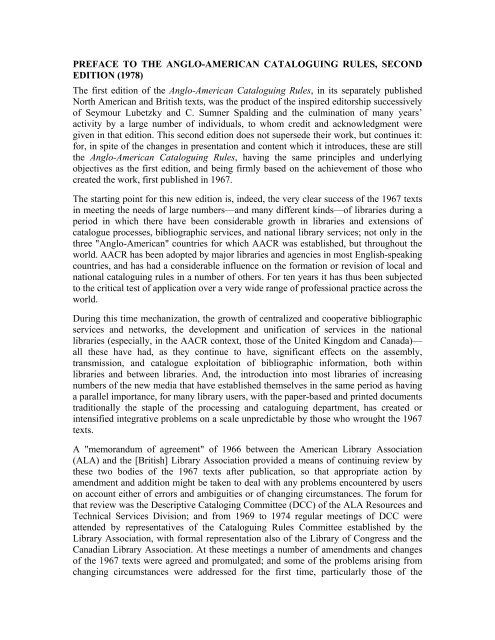

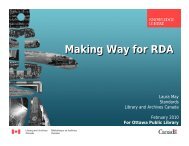
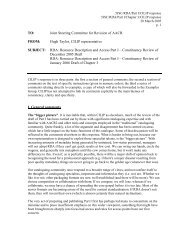
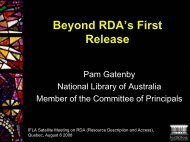

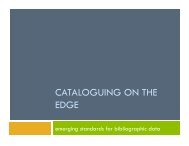

![Presentation slides [PDF] - Joint Steering Committee for ...](https://img.yumpu.com/41621230/1/190x143/presentation-slides-pdf-joint-steering-committee-for-.jpg?quality=85)

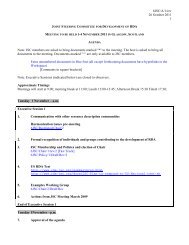
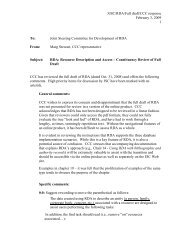
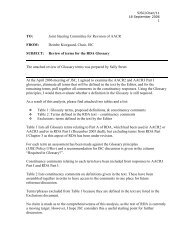
![Presentation slides [PDF] - Joint Steering Committee for ...](https://img.yumpu.com/35256207/1/190x143/presentation-slides-pdf-joint-steering-committee-for-.jpg?quality=85)
